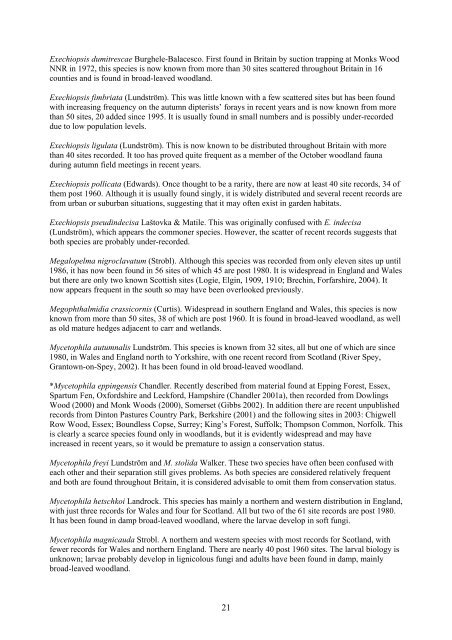Part 2: Nematocera and Aschiza not dealt with by Falk (1991) - JNCC
Part 2: Nematocera and Aschiza not dealt with by Falk (1991) - JNCC
Part 2: Nematocera and Aschiza not dealt with by Falk (1991) - JNCC
You also want an ePaper? Increase the reach of your titles
YUMPU automatically turns print PDFs into web optimized ePapers that Google loves.
Exechiopsis dumitrescae Burghele-Balacesco. First found in Britain <strong>by</strong> suction trapping at Monks Wood<br />
NNR in 1972, this species is now known from more than 30 sites scattered throughout Britain in 16<br />
counties <strong>and</strong> is found in broad-leaved woodl<strong>and</strong>.<br />
Exechiopsis fimbriata (Lundström). This was little known <strong>with</strong> a few scattered sites but has been found<br />
<strong>with</strong> increasing frequency on the autumn dipterists’ forays in recent years <strong>and</strong> is now known from more<br />
than 50 sites, 20 added since 1995. It is usually found in small numbers <strong>and</strong> is possibly under-recorded<br />
due to low population levels.<br />
Exechiopsis ligulata (Lundström). This is now known to be distributed throughout Britain <strong>with</strong> more<br />
than 40 sites recorded. It too has proved quite frequent as a member of the October woodl<strong>and</strong> fauna<br />
during autumn field meetings in recent years.<br />
Exechiopsis pollicata (Edwards). Once thought to be a rarity, there are now at least 40 site records, 34 of<br />
them post 1960. Although it is usually found singly, it is widely distributed <strong>and</strong> several recent records are<br />
from urban or suburban situations, suggesting that it may often exist in garden habitats.<br />
Exechiopsis pseudindecisa Laštovka & Matile. This was originally confused <strong>with</strong> E. indecisa<br />
(Lundström), which appears the commoner species. However, the scatter of recent records suggests that<br />
both species are probably under-recorded.<br />
Megalopelma nigroclavatum (Strobl). Although this species was recorded from only eleven sites up until<br />
1986, it has now been found in 56 sites of which 45 are post 1980. It is widespread in Engl<strong>and</strong> <strong>and</strong> Wales<br />
but there are only two known Scottish sites (Logie, Elgin, 1909, 1910; Brechin, Forfarshire, 2004). It<br />
now appears frequent in the south so may have been overlooked previously.<br />
Megophthalmidia crassicornis (Curtis). Widespread in southern Engl<strong>and</strong> <strong>and</strong> Wales, this species is now<br />
known from more than 50 sites, 38 of which are post 1960. It is found in broad-leaved woodl<strong>and</strong>, as well<br />
as old mature hedges adjacent to carr <strong>and</strong> wetl<strong>and</strong>s.<br />
Mycetophila autumnalis Lundström. This species is known from 32 sites, all but one of which are since<br />
1980, in Wales <strong>and</strong> Engl<strong>and</strong> north to Yorkshire, <strong>with</strong> one recent record from Scotl<strong>and</strong> (River Spey,<br />
Grantown-on-Spey, 2002). It has been found in old broad-leaved woodl<strong>and</strong>.<br />
*Mycetophila eppingensis Ch<strong>and</strong>ler. Recently described from material found at Epping Forest, Essex,<br />
Spartum Fen, Oxfordshire <strong>and</strong> Leckford, Hampshire (Ch<strong>and</strong>ler 2001a), then recorded from Dowlings<br />
Wood (2000) <strong>and</strong> Monk Woods (2000), Somerset (Gibbs 2002). In addition there are recent unpublished<br />
records from Dinton Pastures Country Park, Berkshire (2001) <strong>and</strong> the following sites in 2003: Chigwell<br />
Row Wood, Essex; Boundless Copse, Surrey; King’s Forest, Suffolk; Thompson Common, Norfolk. This<br />
is clearly a scarce species found only in woodl<strong>and</strong>s, but it is evidently widespread <strong>and</strong> may have<br />
increased in recent years, so it would be premature to assign a conservation status.<br />
Mycetophila freyi Lundström <strong>and</strong> M. stolida Walker. These two species have often been confused <strong>with</strong><br />
each other <strong>and</strong> their separation still gives problems. As both species are considered relatively frequent<br />
<strong>and</strong> both are found throughout Britain, it is considered advisable to omit them from conservation status.<br />
Mycetophila hetschkoi L<strong>and</strong>rock. This species has mainly a northern <strong>and</strong> western distribution in Engl<strong>and</strong>,<br />
<strong>with</strong> just three records for Wales <strong>and</strong> four for Scotl<strong>and</strong>. All but two of the 61 site records are post 1980.<br />
It has been found in damp broad-leaved woodl<strong>and</strong>, where the larvae develop in soft fungi.<br />
Mycetophila magnicauda Strobl. A northern <strong>and</strong> western species <strong>with</strong> most records for Scotl<strong>and</strong>, <strong>with</strong><br />
fewer records for Wales <strong>and</strong> northern Engl<strong>and</strong>. There are nearly 40 post 1960 sites. The larval biology is<br />
unknown; larvae probably develop in lignicolous fungi <strong>and</strong> adults have been found in damp, mainly<br />
broad-leaved woodl<strong>and</strong>.<br />
21
















